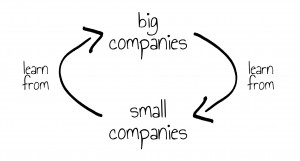High Performing Businesses – does size matter?
15th March 2016
One of the most exciting things about business today is that large and small organisations are playing in the same playground. The advent of the information age, along with rapid technological advancements, have given birth to a global marketplace where everyone is invited.
Barriers to entry are falling, and start-ups are challenging multi-nationals daily for a piece of the pie.
This type of ‘David-vs-Goliath’ competition is very exciting, and helps drive improvement across the board, regardless of your business size, but depending where you sit, it can also be one of the most scary things about business today!
It used to be that bigger always meant better, and that can definitely still be the case. Richard Branson’s Virgin Group has the ability to enter new marketplaces seemingly at will, and make a success of them (with only a very small number of exceptions). Apple dominates a crowded consumer technology market through the sheer scale and quality of their brand, and their ability to drive market demand in new directions.
But there are now so many stories of how the smaller, agile, risk-able companies are coming out on top.
Think of Airbnb in it’s early days – disrupting the entire hotel market and challenging how people think about travel accommodation. Or Uber, the start-up that challenged the traditional taxi and private hire industry. These companies are now huge, but their most spectacular efforts came when they were small start-ups, disrupting the status quo. So does this flip some business models and existing ways of thinking about organisations on its head? Do we need to challenge our existing mindsets that determine how our business ‘should’ act, based on it’s size?
We think so…the wonderful (and scary) parts of today’s businesses is that they can create their own models by cherry-picking the best of big-business and small-business approaches. When this hybrid model is fueled by empowered, engaged, creative employees – this makes the outcomes very hard to replicate, and it massively accelerates growth and change.
These successful new ways of working, are then, counter-intuitive to a lot of existing research, thinking and best-practice. They mean a balance of agility, flexibility AS WELL AS local accountabilities with the structures, ways of working and strategies. Often these are seen as different sides of the coin and ‘either/or’ – but the mix is where many organisations are now thriving.
Our experience is based on years of working with both large and not so large organisations and from seeing where they both can learn lessons from each other. The larger companies typically excel with levels of structure, role accountabilities and systems which make it clear how you work within that particular organisation; whilst the smaller organisations on the other side of the coin, tend to have more flexible ways to create, work together and problem solve and often with higher levels of engagement and autonomy.
It isn’t that one is better than the other, despite small, lean, startup, agile etc being trendy at the moment, and big business being portrayed as great, slow, archaic, lumbering beasts. They both have strengths and weaknesses, that arise from their size, and how their size affects the way they think.
Leaders of large and small organisations are now challenging themselves (and us) with the challenge of if, and how, they can have the best of both worlds – and the great news is they can!
Our way of working is to take the best of both – alignment AND engagement – and through understanding today’s needs and aspirations of a company, applying the right mix for them. Just like the porridge pot – not too much but not too little! Blending the strengths from both approaches into a business, and even just learning to recognise when opportunities play to your strengths, is really important.
By bringing together organisational thinking from both large and small, we can share the ways that you can challenge ‘today’ to become what you want and need ‘tomorrow’. We work with Leaders to be clear what is needed, and to create the spark through the motivation and engagement of their people and teams. This balance and conscious-choice enables the seemingly impossible to become possible…and delivers hard to replicate people-power in the process. The prize? Organisations that are able-to-change and therefore ‘Change-Able’.
So, a thought for today…
What difference could you bring to your organisation if you behaved like organisations who are smaller or larger than yourself?
If you would like to share your thoughts or understand more about what we do, we would love to hear from you.




in